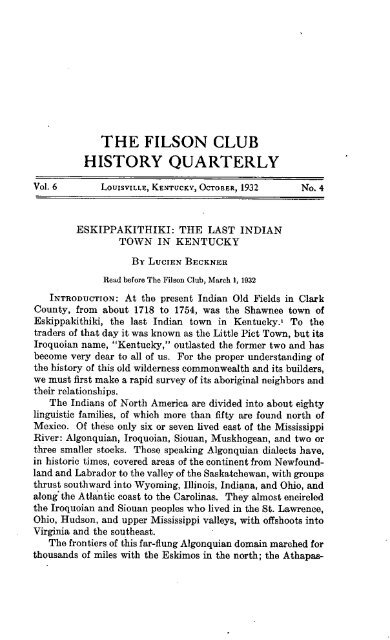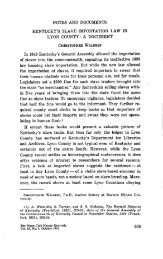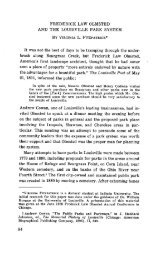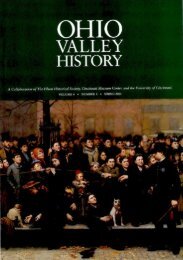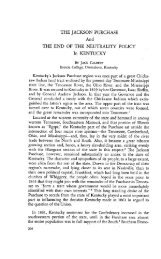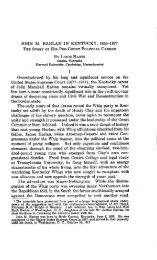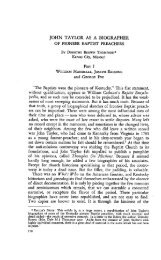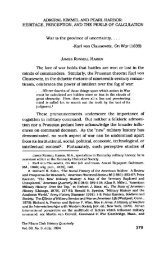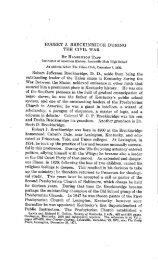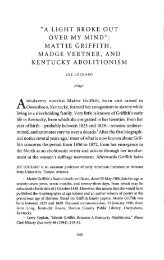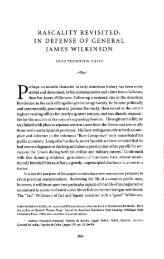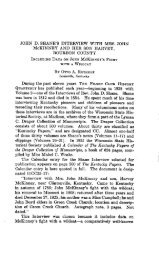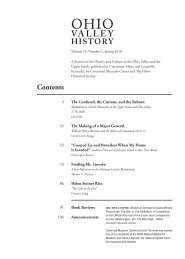Eskippakithiki, The Last Indian Town in Kentucky - The Filson ...
Eskippakithiki, The Last Indian Town in Kentucky - The Filson ...
Eskippakithiki, The Last Indian Town in Kentucky - The Filson ...
Create successful ePaper yourself
Turn your PDF publications into a flip-book with our unique Google optimized e-Paper software.
THE FILSON CLUB<br />
HISTORY QUARTERLY<br />
Vol. 6 LOUISVILLE, KENTVCZV, OCTOBER, 1932 No. 4<br />
ESKIPPAKITHIKI: THE LAST INDIAN<br />
TOWN IN KENTUCKY<br />
BY LUCIEN BECKNER<br />
Read before <strong>The</strong> <strong>Filson</strong> Club, March 1, 1932<br />
INTRODUCTION: At the present <strong>Indian</strong> Old Fields <strong>in</strong> Clark<br />
County, from about 1718 to 1754, was the Shawnee town of<br />
Eskippakithild, the last <strong>Indian</strong> town <strong>in</strong> <strong>Kentucky</strong>. To the<br />
traders of that day it was known as the Little Pict <strong>Town</strong>, but its<br />
Iroquoian name, "<strong>Kentucky</strong>," outlasted the former two and has<br />
become very dear to all of us. For the proper understand<strong>in</strong>g of<br />
the history of this old wilderness commonwealth and its builders,<br />
we must first make a rapid survey of its aborig<strong>in</strong>al neighbors and<br />
their relationships.<br />
<strong>The</strong> <strong>Indian</strong>s of North America are divided <strong>in</strong>to about eighty<br />
l<strong>in</strong>guistic families, of which more than fifty are found north of<br />
Mexico. Of these only six or seven lived east of the Mississippi<br />
River: Algonquian, Iroquoian, Siouan, Muskhogean, and two or<br />
three smaller stocks. Those speak<strong>in</strong>g Algonquian dialects have,<br />
<strong>in</strong> historic times, covered areas of the cont<strong>in</strong>ent from Newfoundland<br />
and Labrador to the valley of the Saskatchewan, with groups<br />
thrust southward <strong>in</strong>to Wyom<strong>in</strong>g, Ill<strong>in</strong>ois, <strong>Indian</strong>a , and Ohio, and<br />
along" the Atlantic coast to the Carol<strong>in</strong>as. <strong>The</strong>y almost encircled<br />
the Iroquoian and Siouan peoples who lived <strong>in</strong> the St. Lawrence,<br />
Ohio, Hudson, and upper Mississippi valleys, with offshoots <strong>in</strong>to<br />
Virg<strong>in</strong>ia and the southeast.<br />
<strong>The</strong> frontiers of this far-flung Algonquian doma<strong>in</strong> marched for<br />
thousands of miles with the Eskimos <strong>in</strong> the north; the Athapas-
356 <strong>The</strong> <strong>Filson</strong> Club History .Quarterly [ Vol. 6<br />
cans <strong>in</strong> the northwest; the Siouans <strong>in</strong> the west, <strong>in</strong> the Ohio and<br />
Great Lakes valleys, and along the Atlantic slopes; the Muskhogeans<br />
and Yuchians <strong>in</strong> the south; and the Iroquoians <strong>in</strong> the valleys<br />
of the St. Lawrence, Hudson, and Susquehanna rivers, and<br />
<strong>in</strong> the Carol<strong>in</strong>a hills. <strong>The</strong> eastern Algonquian tribes best known<br />
to us were the Algonk<strong>in</strong>s, Pequots, Narragansetts, Mohicans,<br />
Delawares, and Powhatans, listed from north to south along the<br />
seaboard. <strong>The</strong>y had a great effect on our early history, and from<br />
them has been derived the notion most of us have of the <strong>Indian</strong>-bloodthirsty,<br />
and low <strong>in</strong> culture--a nomad hunter whose squaw<br />
does the hard work. In the west their best known tribes were the<br />
Shawnees, Miamis, Ottawas, Ill<strong>in</strong>ois, Chippeways, Cheyennes,<br />
and Crees. <strong>The</strong>se were like their eastern k<strong>in</strong> <strong>in</strong> culture. From<br />
Algonquian tongues have come our words squaw, papoose, wigwam,<br />
caucus, tomahawk, moose, raccoon, opossum, Massachusetts,<br />
Connecticut, Ill<strong>in</strong>ois, Wiscons<strong>in</strong>, Michigan, Wyom<strong>in</strong>g,<br />
Mississippi, Manitoba, Saskatchewan, and many others.<br />
<strong>The</strong> best known Iroquoian tribes were those of the Five Nations:<br />
Mohawks or Iroquois, Cayugas, Oneidas, Onondagas, and<br />
Seneeas, who were also called, collectively, the Iroquois, the Senecas,<br />
the Confederacy, and the League, whose homes were <strong>in</strong><br />
New York; the Tuscaroras of North Carol<strong>in</strong>a, who moved north<br />
<strong>in</strong> the first half of the eighteenth century and jo<strong>in</strong>ed the League,<br />
caus<strong>in</strong>g it to be called thereafter the Six Nations; the Conestogas<br />
of Maryland and Pennsylvania; the Hurons who, driven from the<br />
north of Lake Erie by the Five Nations, became known to our<br />
pioneers as Wyandots; and lastly the Cherokees, whose language<br />
and customs were so unlike the other Iroquoians that they are<br />
seldom thought of as the same. <strong>The</strong> Iroquoians have given us the<br />
words Erie, Huron, Niagara, Quebec, Ontario, Ohio, Tennessee,<br />
and <strong>Kentucky</strong>.<br />
<strong>The</strong> eastern Siouans are but slightly known to the casual reader.<br />
<strong>The</strong>ir most noted tribe was the Catawba which, driven out of<br />
the upper Ohio Valley by the Iroquois, about 1650, sett!ed <strong>in</strong> the<br />
Carol<strong>in</strong>as. <strong>The</strong> Siouans were sedentary, great corn-growers, more<br />
civilized than the <strong>Indian</strong>s surround<strong>in</strong>g them, and were the builders<br />
of the great earthworks and hill-forts of Ohio, <strong>Indian</strong>a, Ill<strong>in</strong>ois,<br />
Wiscons<strong>in</strong>, the Dakotas, Iowa, Missouri, West Virg<strong>in</strong>ia, Kentueky,<br />
Virg<strong>in</strong>ia, and Georgia. <strong>The</strong>ir modern descendants, Sioux,<br />
Omahas, Osages, Dakotas, Mandans, etc., are better known to us.
Vol. 6 ] <strong>The</strong> <strong>Filson</strong> Club History Quarterly 357<br />
Tepee, Paducah, Omaha, Chatteroi, Kanawha, Missouri, Arkansas,<br />
Kansas, Iowa, Nebraska, and Dakota arc Siouan words.<br />
Among the Muskhogeans were the Chickasaws, Choctaws,<br />
Creeks, Sem<strong>in</strong>oles, Natchez, and Yemasees, who lived <strong>in</strong> the eastern<br />
Gulf States, <strong>in</strong> Tennessee, and <strong>in</strong> western <strong>Kentucky</strong>. <strong>The</strong>y<br />
<strong>in</strong>fluenced white settlement greatly and were a valiant, cultured,<br />
and able people. Many northern tribes fled to them for protection<br />
from the savage Iroquois, who never attacked them successfully.<br />
<strong>The</strong>y have given us many geographic terms, Appalachian,<br />
Caloosahatchie, Tuscaloosa, Tombigbee, Natchez, Yazoo, Alabama,<br />
and Oklahoma be<strong>in</strong>g some of them.<br />
THE SRAWNEES: Of all these ancient peoples, for purposes of<br />
this story, our greatest <strong>in</strong>terest is <strong>in</strong> the Shawnees who had, perhaps,<br />
the most eventful history of any tribe <strong>in</strong> the United States,<br />
a section of which, the Picts or Piquas, built the village of <strong>Eskippakithiki</strong><br />
<strong>in</strong> the southeastern corner of the present Clark County,<br />
<strong>Kentucky</strong>. Eskippaki is a Shawnee word mean<strong>in</strong>g "blue-lick," as<br />
a salt-sulphur spr<strong>in</strong>g was called; and (th)iki is a locative end<strong>in</strong>g<br />
which can be translated "place," the whole mean<strong>in</strong>g "blue-lickplace."<br />
<strong>The</strong> word Shawnee means "southerner" <strong>in</strong> the Algonquian<br />
tongues; and, historically, it became applied to those <strong>Indian</strong>s who,<br />
break<strong>in</strong>g away from the Outagami or Sauk Nation <strong>in</strong> Wiscons<strong>in</strong>,<br />
and mov<strong>in</strong>g southward across the Ohio, took the advance of the<br />
Algonquian <strong>in</strong>vasion <strong>in</strong> that direction, thereby acquir<strong>in</strong>g their<br />
new name. This southward movement of the Shawnees was the<br />
last part of a general movement of the Algonquians that began-accord<strong>in</strong>g<br />
to the ralam Olum, the birchbark historic record of the<br />
Delawares, a closely related Algonquian tribe--shortly before<br />
Leif Ericsson landed <strong>in</strong> V<strong>in</strong>land. Before that time all of the Algonquians<br />
seem to have lived north of the Great Lakes.<br />
When the Shawnees started south is not certa<strong>in</strong>ly known.<br />
However, it was not long before the French came to Ill<strong>in</strong>ois, for<br />
the Jesuit Relations of 1648 shows that some of them were with<br />
the Mascout<strong>in</strong>s <strong>in</strong> Ill<strong>in</strong>ois at that time; but before 1669 they had<br />
fled southward, try<strong>in</strong>g to escape the fierce war parties of the Five<br />
Nations. <strong>The</strong> Jesuit Relations of 1670 says that they then lived<br />
some distance to the southeast of Ill<strong>in</strong>ois, which puts them <strong>in</strong> Kentueky<br />
or Tennessee.
358 <strong>The</strong> <strong>Filson</strong> Club Hislory Quarterly [Vol. 6<br />
Before the white man reached America, the savage Algonquians,<br />
who had not yet lost their northern hard<strong>in</strong>ess, had been<br />
hurl<strong>in</strong>g themselves aga<strong>in</strong>st the Easterners--sedentary Siouans<br />
and the Iroquoians--until, <strong>in</strong> their desperation, five tribes of the<br />
latter, about 1570, formed the confederacy known as the Five<br />
Nations, the most efficient <strong>in</strong> eastern North America. Gett<strong>in</strong>g<br />
guns from the Dutch, about 1630-1640, many years before the<br />
<strong>Indian</strong>s of the <strong>in</strong>terior received them, they turned on their tormentors<br />
and crushed them. In their raids <strong>in</strong>to the west they<br />
reached the Shawnees about 1655 and, accord<strong>in</strong>g to Charlevoix,<br />
conquered them by 1672.<br />
By the second half of the seventeenth century many Shawnees<br />
had made their way up the southern branches of the Ohio, where<br />
they built their towns of Chaskepe and Meguachaika on a river<br />
which is called on Franquel<strong>in</strong>'s map of 1684 the "Skipaki cipi ou<br />
Riviere bleue," which is either the Red or the Lick<strong>in</strong>g River. <strong>The</strong><br />
topography and dra<strong>in</strong>age of the Ohio Valley were not understood<br />
<strong>in</strong> those long-ago days and the old maps are so badly scrambled<br />
that it too often is impossible to he certa<strong>in</strong> about locations or the<br />
modern equivalents of their obsolete names. In 1673, while on<br />
the Mississippi pass<strong>in</strong>g the mouth of the Ohio, Marquette notes<br />
that the Ohio is "<strong>in</strong>habited by a people called Chaouanons<br />
[French spell<strong>in</strong>g of Shawnees] <strong>in</strong> such numbers that they reckon<br />
25 villages <strong>in</strong> one district and 15 <strong>in</strong> another, ly<strong>in</strong>g quite near to<br />
each other."<br />
Consider<strong>in</strong>g the date and the sources from which Franquel<strong>in</strong><br />
compiled his map and that the country north of the Ohio had been<br />
swept almost clean of <strong>in</strong>habitants by this time, the settlements<br />
referred to by Marquette must have been those towns on the Skipaki<br />
cipi <strong>in</strong> <strong>Kentucky</strong>. In the same account we axe given a<br />
glimpse of the effect of the Iroquois' raids on the southern <strong>Indian</strong>s,<br />
for he says: "and because these poor people can not defend themselves<br />
[not hav<strong>in</strong>g firearms], they allow themselves to be captured<br />
and taken like flocks of sheep; and, <strong>in</strong>nocent though they are, they<br />
nevertheless sometimes experience the barbarity of the Iroquois,<br />
who cruelly burn them."<br />
That the Shawnees were not nerveless cowards, their whole<br />
after-history pr0claSms., From 1655 to 1815, for one hundred and<br />
sixty years, they were always at war; and from 1755 to the end of<br />
the War of 1812, for sixty years, they were the backbone of the
Vol. 6 ] <strong>The</strong> Fdson Club History Quarterly 359<br />
opposition to the white advance, which was a longer time than the<br />
opposition of any other <strong>Indian</strong> people except the Iroquois. Hav<strong>in</strong>g<br />
no European arms <strong>in</strong> the seventeenth century, they were compelled<br />
to flee from the well-armed Iroquois. Some fled to the<br />
Miamis, north of the Ohio, unit<strong>in</strong>g with them aga<strong>in</strong>st the common<br />
enemy and w<strong>in</strong>n<strong>in</strong>g for both swift Iroquoian vengeance;<br />
others fled along the Warriors' Path, through the Cumberland<br />
Gap, to the Spanish <strong>in</strong> Florida. LaSalle <strong>in</strong>vited the few left <strong>in</strong><br />
<strong>Kentucky</strong> to come to Ill<strong>in</strong>ois, where he built Fort St. Louis, <strong>in</strong><br />
1681, for their protection. <strong>The</strong>re some of the Shawnees built a<br />
new Chaskepe, and became children of Louis XIV, K<strong>in</strong>g of<br />
France, and were <strong>in</strong>oculated with sympathies which governed<br />
much of the subsequent Shawnee history. S<strong>in</strong>ce then, with the<br />
exception of <strong>Eskippakithiki</strong>, a few houses opposite Lower Shawnee<br />
<strong>Town</strong> at the mouth of the Scioto, and a temporary village or<br />
two, there have been no <strong>Indian</strong> residents <strong>in</strong> <strong>Kentucky</strong>.*<br />
THE SHAWNEES IN CAROLINA: <strong>The</strong>'Warriors' Path or Trace<br />
crossed the Ohio River at the mouth of Cab<strong>in</strong> Creek <strong>in</strong> Mason<br />
County, <strong>Kentucky</strong>, below the mouth of the Scioto, where Portsmouth,<br />
Ohio, now stands. This Trace ran to the Upper Blue<br />
Licks, <strong>in</strong> Flem<strong>in</strong>g County; thence to <strong>Eskippakithiki</strong>, which the<br />
white settlers later renamed <strong>Indian</strong> Old Fields, <strong>in</strong> Clark County;<br />
thence up Station Camp Creek, <strong>in</strong> Estill County, to the Pictured<br />
Caves at its head near the mouth of Red Lick Creek; thence<br />
through the low hills of Jackson County to the Flat Lick near<br />
Barbourville, <strong>in</strong> Knox County; and thence out of <strong>Kentucky</strong><br />
through Cumberland Gap: and along tl e back border of the Carol<strong>in</strong>as<br />
to the Spanish settlements <strong>in</strong> Georgia and Florida. This was<br />
from prehistoric times a major trade route down which went copper,<br />
northern furs, and glacial pebbles for mak<strong>in</strong>g stone axes; and<br />
up which came sea-shells, southern plumage, and mica.<br />
Georgia, at the time this story beg<strong>in</strong>s, had not been settled by<br />
the English and was considered a part of Florida, the Spanish hav<strong>in</strong>g<br />
settlements on the coast and gold m<strong>in</strong>es <strong>in</strong> the <strong>in</strong>terior. Upon<br />
the southern end of this Trace the Shawnees--or Savannahs as<br />
they were there called--bnilt their towns, on the waters of the Savannah<br />
River, from whence they robbed the Spanish and traded<br />
with the South Carol<strong>in</strong>a English for the firearms and edged tools<br />
which had become so necessary for their existence. Rich <strong>in</strong> per-
360 <strong>The</strong> <strong>Filson</strong> Club History Quarterly [ Vol. 6<br />
sonality, they impressed their names on the Savannah and Suwanee<br />
Rivers.<br />
In 1680 they made their welcome <strong>in</strong> their new homes secure by<br />
sid<strong>in</strong>g with the South Carol<strong>in</strong>ians <strong>in</strong> their war aga<strong>in</strong>st the Yuehi<br />
<strong>Indian</strong>s. In 1706, however, braves from one of the Savannah<br />
towns killed several whites, perhaps <strong>in</strong> North Carol<strong>in</strong>a, which<br />
government sent a militia force and a band of Catawba <strong>Indian</strong>s<br />
aga<strong>in</strong>st the offend<strong>in</strong>g town. <strong>The</strong> result is not known, but many of<br />
the Shawnees fled about this time to the Delawares, their Algonquian<br />
k<strong>in</strong> <strong>in</strong> Pennsylvania.<br />
ESKIPPECK ON THE APALACHICOLA: <strong>The</strong> next year, 1707,<br />
Lamhatty, a southern <strong>Indian</strong> who had been taken captive to Virg<strong>in</strong>ia,<br />
made a statement to Beverly, the Virg<strong>in</strong>ia historian, about<br />
the <strong>Indian</strong>s of the South and drew a map to illustrate his story.<br />
Upon this map he placed a town on the lower Apalachicola River<br />
that, <strong>in</strong> the published versions, is pr<strong>in</strong>ted "Ephippeck," which is<br />
very unlike other Southern <strong>Indian</strong> names. It never appears on<br />
later maps, perhaps because the Apalachicola was raided about<br />
that time by the Tuscaroras and many of its denizens scattercd.<br />
<strong>The</strong> word is evidently a misread<strong>in</strong>g for Eskippeek, <strong>in</strong> which the<br />
obsolete long form of s, which looks like a p, was used; it was followed<br />
by a k, <strong>in</strong> which the f<strong>in</strong>al loop is so open that it has been<br />
mistaken for an h. This word was used as a town name possibly<br />
by the same Shawnees who came from the Skipaki eipi <strong>in</strong> <strong>Kentucky</strong><br />
(eipi means river <strong>in</strong> Algonquian tongues, as seen <strong>in</strong> the<br />
word Mississippi).<br />
<strong>The</strong>y are probably the Shawnees who, about this time, started<br />
back to <strong>Kentucky</strong> to build their new Eskippaki at <strong>Indian</strong> Old<br />
Fields. In support of this supposition there are not only the identity<br />
of names and a conformity <strong>in</strong> timel<strong>in</strong>ess but also the fact that<br />
Catahecassa or Black Hoof (for years head chief of the Shawnccs<br />
until Teeumseh rebelled aga<strong>in</strong>st him <strong>in</strong> his old age, and who had<br />
been a resident of <strong>Eskippakithiki</strong>), told Colonel .lohn Johnston,<br />
the Federal <strong>Indian</strong> agent amongst the Ohio and <strong>Indian</strong>a tribes<br />
from 1812 to 1842, that his people came from the South where<br />
they had lived not far from the sea. <strong>The</strong> upper waters of the Savannah,<br />
where most of the southern Shawnecs lived, were some<br />
distance from the sea, and its lower waters Were settled by whites;<br />
but on the lower waters of the Apalachicola, Eskippeck was closer<br />
to the Gulf and had no white neighbors.
Vol. 6 ] <strong>The</strong> <strong>Filson</strong> Club History Quarterly 361<br />
Ramsey <strong>in</strong> his Annals of Tennessee gives us an <strong>in</strong>cident <strong>in</strong> the<br />
northward trek of what must have been the Shawnees Who settled<br />
<strong>in</strong> <strong>Kentucky</strong>, because they are too far west to have been those<br />
who went to Permsylva a. He says: "M. Charlcville, a French<br />
trader from Crozat's colony at New Orleans, came <strong>in</strong> 1714 among<br />
the Shawnees, then <strong>in</strong>habit<strong>in</strong>g the country on the Cumberland<br />
river; and traded with them. His store was built on a mound,<br />
near the present site of Nashville." Here, he says, the Shawnees<br />
had "forted themselves, and ma<strong>in</strong>ta<strong>in</strong>ed a protracted war for the<br />
possession (if their country." However, the Chickasaws and<br />
Cherokees, not lik<strong>in</strong>g such squatters <strong>in</strong> their richest hunt<strong>in</strong>g country,<br />
soon drove them out. Pcnicaut, the French missionary, <strong>in</strong><br />
his Relation for 1714 says, that he "found, among the Natchez,<br />
some slaves belong<strong>in</strong>g to the nation of the Chaouanons who had<br />
been captured by a strong party of Chickasaws, Yazous, and<br />
Natchez, who, under the pretext of visit<strong>in</strong>g their village for the<br />
purpose of danc<strong>in</strong>g the calumet of peace, had attacked them <strong>in</strong> the<br />
most base and treacherous manner, and killed their grand chief,<br />
dth most of his family, took eleven prisoners, among whom was<br />
the wife of the chief, and brought them to Natchez."8 <strong>The</strong>re<br />
seems to have been no game laws protect<strong>in</strong>g the poor, wander<strong>in</strong>g,<br />
home-hunt<strong>in</strong>g Shawnees.<br />
<strong>The</strong> only places open to these flee<strong>in</strong>g Eskippeckians were the<br />
French settlements <strong>in</strong> Ill<strong>in</strong>ois, the deserted <strong>Kentucky</strong> country,<br />
the Creek towns <strong>in</strong> Georgia and Alabama, and the Delaware country<br />
<strong>in</strong> Pennsylvania. Had they gone to Ill<strong>in</strong>ois the French records<br />
would have shown it. To go south to the Creeks would be to go<br />
back <strong>in</strong>to that from which they were flee<strong>in</strong>g. East and west were<br />
closed to them by the vigilant Cherokees and Chickasaws. To go<br />
north of the Ohio and east of the French <strong>in</strong>fluence would put them<br />
<strong>in</strong> the country also claimed by the dread and jealous Iroquois,<br />
their ancient enemies. <strong>The</strong> route to the Delawares led through<br />
hostile Cherokee or Iroquois territory, and therefore for the time<br />
impassible. <strong>The</strong>ir most probable route was down the Cumberland<br />
to the Ohio, thence up it to a settlement <strong>in</strong> central <strong>Kentucky</strong>--to<br />
the land where many of them had been born, but which<br />
had been vacant ever s<strong>in</strong>ce their flight from it thirty or forty<br />
years before.<br />
<strong>The</strong>y must have stopped for a year or so at the mouth of the<br />
Cumberland, to recoup their losses and reorganize, for Moll's map
362 <strong>The</strong> Fdson Club History Quarterly [ Vol. 6<br />
of 1720 (but'made from data probably gathered four or five years<br />
previously) shows a Shawnee town there, which must have been a<br />
transient town, as it does not occur on other maps, before nor<br />
after. Because there is no record of southern Shawnees settl<strong>in</strong>g<br />
anywhere else save <strong>in</strong> the Delaware country of Pennsylvania, and<br />
because this is the only group of Shawnces which the Cherokees<br />
kept away from the roads of eastern Tennessee and southwestern<br />
Virg<strong>in</strong>ia, which led to the Delaware country, these must have<br />
been the founders of the new <strong>Eskippakithiki</strong> <strong>in</strong> <strong>Kentucky</strong>. All<br />
other Shawnee movements from the South about this time seem to<br />
be accounted for by their go<strong>in</strong>g to the Delawares <strong>in</strong> Pennsylvania ,<br />
or to the Creeks.<br />
On De Lisle's map of 1718 there is a "Tongoria" town <strong>in</strong> northeastern<br />
<strong>Kentucky</strong>. This word is thought to be a variant of "Taogria"--!ndians<br />
whom the French missionary, Father Gravier, <strong>in</strong><br />
his Relation of 1700, says "spoke the Chaouanon tongue." <strong>The</strong><br />
location of this town is not just where <strong>Eskippakithiki</strong> would be,<br />
but, of a map made up from verbal reports of <strong>Indian</strong>s and ignorant<br />
traders, too much exactness must not be demanded. As we<br />
f<strong>in</strong>d no evidence of any other <strong>Indian</strong> town <strong>in</strong> <strong>Kentucky</strong>, at that<br />
time nor subsequently, we may safely beg<strong>in</strong> to date the history of<br />
Estdppakithiki from a year or so before 1718, the date of this map.<br />
<strong>The</strong> late Dr. Cyrus Thomas, of the national Bureau of Ethnology,<br />
thought it was established about 1724--but upon what<br />
authority is unknown. Dr. Daniel G. Br<strong>in</strong>ton, one of our greatest<br />
authorities on the eastern <strong>Indian</strong>s, thought it was founded by<br />
those Shawnees who went from Carol<strong>in</strong>a <strong>in</strong> 1731., But the report<br />
of James LeTort, the Pennsylvania <strong>Indian</strong> agent, shows that they<br />
came directly to the Potomac and thence to Pennsylvania.,° Besides,<br />
the Pennsylvania Shawnees were of the Hathawekela<br />
branch of the Shawnecs, while the <strong>Eskippakithiki</strong>ans were of the<br />
Pict branch, for which reason the traders always called it <strong>The</strong><br />
Little Pict <strong>Town</strong>, to dist<strong>in</strong>guish it from the larger Pict town near<br />
present Piqua, Ohio.<br />
Colonel John Johnston says that Black Hoof was born <strong>in</strong> 1731 ;<br />
and Black Hoof, while visit<strong>in</strong>g the people of <strong>Indian</strong> 01d Fields <strong>in</strong><br />
1816, told them that he was born there. Colonel Johnston also<br />
says that Black Hoof told him he was born <strong>in</strong> the South and remembered<br />
bath<strong>in</strong>g <strong>in</strong> the sea when he was a boy. If he was born<br />
at Eskippakithild <strong>in</strong> 1731 and his family jo<strong>in</strong>ed Chartier--of
Vol. 6 ] <strong>The</strong> <strong>Filson</strong> Club History Quarterly 363<br />
whom later--and went south <strong>in</strong> 1748, he may have bathed <strong>in</strong> the<br />
sea when a boy. But Black Hoof made the settlers at <strong>Indian</strong> Old<br />
Fields believe that he was, at the time of his visit, over one hundred<br />
years old. If this were true, he might still have bathed <strong>in</strong> the<br />
sea when a boy, but could hardly have been born at <strong>Eskippakithiki</strong>.<br />
<strong>The</strong>se two tales seem like an <strong>in</strong>soluble snarl.<br />
<strong>The</strong> letter of Postmaster Fickl<strong>in</strong> of Lex<strong>in</strong>gton, <strong>Kentucky</strong>, to<br />
Schooleraft, dated August 31, 1847, is probably the first effort to<br />
tell the story of <strong>Eskippakithiki</strong>. It gives a pioneer view of the<br />
history of some of the Shawnees who lived <strong>in</strong> this ancient <strong>Indian</strong><br />
town. It is so lack<strong>in</strong>g <strong>in</strong> def<strong>in</strong>iteness that no historian heretofore<br />
has attempted to expla<strong>in</strong> it. Btlt its pert<strong>in</strong>ency to this story compels<br />
it to be <strong>in</strong>corporated here. Its explanation will be attempted<br />
by <strong>in</strong>sert<strong>in</strong>g <strong>in</strong> brackets the explanatory words or phrases. <strong>The</strong><br />
pert<strong>in</strong>ent extract is as follows:<br />
"A discontented portion of the Shawnee tribe, from Virg<strong>in</strong>ia<br />
[western Pennsylvania and Ohio were claimed by Virg<strong>in</strong>ia], broke<br />
off from the nation [Chartier's rebellion], which had removed to<br />
the Scioto country, <strong>in</strong> Ohio, about the year 1730 [1728], [he is here<br />
confused with the story of Lower Shawnee <strong>Town</strong> at the mouth of<br />
Scioto], and formed a town, known to the whites by the name of<br />
Lulbegrud [this was never true; Boone's deposition here<strong>in</strong> later<br />
given shows the correct pioneer usage of "Lulbegrud"], <strong>in</strong> what<br />
is now Clark county, about thirty miles east of this place [Lex<strong>in</strong>gton].<br />
<strong>The</strong> tribe left this country about 1750 [1747] and went<br />
to East Tennessee, to the Cherokee Nation. [He is tell<strong>in</strong>g about<br />
Chartier's flight to the Cherokees <strong>in</strong> 1748, for the Esldppakithiki<br />
Shawnees went directly to Chillicothe when they left <strong>Eskippakithiki</strong>.]<br />
Soon after they returned to Ohio and jo<strong>in</strong>ed the rest of the<br />
nation after spend<strong>in</strong>g a few years on the Ohio river, giv<strong>in</strong>g name<br />
to Shawneetown, <strong>in</strong> the State of Ill<strong>in</strong>ois, a place of some note at<br />
that time. [In this last statement it is clear that he is confus<strong>in</strong>g<br />
two widel separated events: the abandonment of <strong>Eskippakithiki</strong><br />
<strong>in</strong> 1754, and the return of the Chartier stragglers <strong>in</strong> 1761<br />
from Shawneetown.] This <strong>in</strong>formation is founded on the account<br />
of the <strong>Indian</strong>s at the first settlement of this State, and .s<strong>in</strong>ce confirmed<br />
by Black Hoof, a native of Lulbegrud, who visited this<br />
country <strong>in</strong> 1816," etc.<br />
Fickl<strong>in</strong>'s three statements that "Lulbegrud" was founded by<br />
Chartier (who we know arrived there <strong>in</strong> 1745 and left by 1747) ;
364 <strong>The</strong> <strong>Filson</strong> Club History Quarterly [Vol. 6<br />
that the Shawnees left "Lnlbegrud" about 1750 [1747], imply<strong>in</strong>g<br />
that that was the last of the town; and that Black Hoof was born<br />
there, do not fit, <strong>in</strong> spite of the alleged confirmation of these statements<br />
by Black Hoof himself; for the latter, <strong>in</strong> his visit to <strong>Indian</strong><br />
Old Fields ["Lulbegrud"] <strong>in</strong> 1816, told the settlers that he was<br />
born there and spent his boyhood there, po<strong>in</strong>t<strong>in</strong>g out to them<br />
places of <strong>in</strong>terest he remembered; and further told them that he<br />
shot at Wash<strong>in</strong>gton at Braddock's defeat <strong>in</strong> 1755. Now, had<br />
"Lulbegrud" been but the temporary creation of Chartier's tribe,<br />
as Fickl<strong>in</strong>'s letter states, he left "Lulbegrud" when not over two<br />
years of age, too tender for remember<strong>in</strong>g places and events, and<br />
was also a warrior at Braddock's defeat when not over ten years of<br />
age/ But <strong>in</strong> spite of its mistakes Fickl<strong>in</strong>'s letter is a :emarkable<br />
document, conta<strong>in</strong><strong>in</strong>g many essences of fact, show<strong>in</strong>g, however,<br />
the weaknesses of tradition and, <strong>in</strong>versely, the advantages which<br />
access to records have given the modern historian.<br />
THE FRENCH CENSVS OF 1736: In the seventeenth and part<br />
of the eighteenth centuries central <strong>Kentucky</strong>, as part of the Ohio<br />
Valley, was claimed by the French, who pretended to hold it<br />
aga<strong>in</strong>st the Iroquois and seaboard English. This claim was a protection<br />
to our wander<strong>in</strong>g Shawnees, s<strong>in</strong>ce it made the Iroquois unwill<strong>in</strong>g<br />
to attack them and made each party their defendant<br />
aga<strong>in</strong>st the other. <strong>The</strong> Iroquois understood the Shawnee policy,<br />
for, <strong>in</strong> a council <strong>in</strong> 1770, they upbraided them for settl<strong>in</strong>g so far<br />
down the Ohio as to be beyond the Iroquois control.<br />
In 1736 the French-Canadian government made a census of<br />
the tribes connected with it and, as a gesture about their claim to<br />
the Ohio Valley by right of discovery, one of the enumerated<br />
tribes is the "Chaouanons, towards Carol<strong>in</strong>a, two hundred men."11<br />
<strong>The</strong> French Canadians certa<strong>in</strong>ly would not claim the Shawneos<br />
1Ldng <strong>in</strong> Carol<strong>in</strong>a, or Georgia, or Alabama, all of whom were beyond<br />
Canadian jurisdiction and under English control ; nor would<br />
they claim any others closer to Carol<strong>in</strong>a than <strong>Kentucky</strong>, for they<br />
had no control of tlie Tennessee country, <strong>in</strong>habited by the Chickasaws<br />
and Cherokees, who were too far away and, besides, strictly<br />
pro-English. To have been "towards Carol<strong>in</strong>a," as described,<br />
these Shawnees would have had to have been south of the Ohio.<br />
On the Van Keulen map of 1720, only sixteen years prior to the<br />
census, the <strong>Kentucky</strong> River is set out as the "route qui los Francois<br />
tienient pour se rendre a la Carol<strong>in</strong>e," which means the route
Voh 6] <strong>The</strong> <strong>Filson</strong> Club History Quarterly 365<br />
which the French take when they _resort to Carol<strong>in</strong>a. Be<strong>in</strong>g on<br />
this "route" as well as on the Warriors' Trace from Ohio to Carol<strong>in</strong>a,<br />
as shown on Evans' map of 1755, we have no alternative but<br />
to believe that this census is of our <strong>Eskippakithiki</strong>. Two hundred<br />
men implies from at least eight hundred to one thousand people.<br />
This town was then the metropolis of <strong>Kentucky</strong>, of Shawnee<br />
<strong>Kentucky</strong>, of Canadian <strong>Kentucky</strong>, of Iroquoian <strong>Kentucky</strong>, when<br />
all Kentuckians did homage to Louis, the Grand Monarque of<br />
France, serenely oblivious, <strong>in</strong> the distractions of his pleasure-seek<strong>in</strong>g<br />
court, of the huddle of dusky savages who, <strong>in</strong> the deep forests<br />
of the New World, were achiev<strong>in</strong>g life and security under the<br />
psychologic <strong>in</strong>fluence of his potent name; and did homage also to<br />
the dusky diplomats and warriors of the "Long House" of the<br />
]roquois, <strong>in</strong> the far away valley of the Mohawk, more ' frightful<br />
and more potent, <strong>in</strong> time and place, than the Grand Monarque.<br />
<strong>Kentucky</strong>'s present metropolis bears K<strong>in</strong>g Louis' name, but<br />
acknowledges no feudal sovereign, no swarthy overlords.<br />
ThE MURDEa OF THE SENECA CHIEF: A band of young Shawnees,<br />
at the time liv<strong>in</strong>g on the upper Allegheny, <strong>in</strong> 1734 killed a<br />
chief of the Senecas, br<strong>in</strong>g<strong>in</strong>g upon themselves the wrath of the<br />
Iroquois and the Pennsylvania government. John and Thomas<br />
Penn, <strong>in</strong> a letter to the Senecas dated July 29, 1735, say that they<br />
understand that the Shawnees who killed the chief came to the<br />
Allegheny "about four years s<strong>in</strong>ce," . . . "from the westward,<br />
or southward of the Ohio."2 This sounds like they came from<br />
<strong>Eskippakithiki</strong>, as it is the only Shawnee settlement that could be<br />
so described at that time. <strong>The</strong> murderers fled at once down the<br />
Ohio and, as they would not have dared to stop at the newly<br />
founded Lower Shawnee <strong>Town</strong> at the mouth of the Scioto, because<br />
it was too close to their enemies, they doubtless took refuge<br />
with their k<strong>in</strong> at <strong>Eskippakithiki</strong>, who had no love for the Senecas.<br />
THE CATAWBA SIEGE: This affront to the Scnecas, the<br />
strongest member of the Iroquois League at the time, may have<br />
been the cause of the Catawba attack on Eskippakitlfiki <strong>in</strong> 1736,<br />
two years later. Afraid to attack a town under French protection.<br />
because of their own vulnerability along the St. Lawrence French<br />
frontier, they may have sicked onto it the Catawbas, who were<br />
not only historically anti-French but were too far from the seat<br />
of French power to have any political qualms. Whatever the<br />
cause, the Catawbas fell on <strong>Eskippakithiki</strong> <strong>in</strong> 1736 and probably
366 <strong>The</strong> <strong>Filson</strong> Club History Quarterly [ Vol. 6<br />
hung around pick<strong>in</strong>g off hunters and stragglers, as the <strong>Indian</strong><br />
mode of warfare was caus<strong>in</strong>g the affair to be spoken of as a siege.<br />
No <strong>in</strong>cidents of this little war are known, but it is presumable that<br />
the murderers were hot caught, for if they had been, Iroquois<br />
action and satisfaction would have found some expression of it <strong>in</strong><br />
contemporary records.l* About this time the Catawbas murdered<br />
and robbed two Pennsylvania traders "on the Ohio" an act which<br />
may be a part of this disturbance, but, if so, its connection with it<br />
is not proven.<br />
EARLY TRADERS: Between this time and the beg<strong>in</strong>n<strong>in</strong>g of the<br />
French and <strong>Indian</strong> War many Pennsylvania and Carol<strong>in</strong>a traders<br />
were struggl<strong>in</strong>g for the trade of the Ohio River and the <strong>in</strong>terior<br />
peoples. Amongst them were James Le Tort, the <strong>in</strong>terpreter;<br />
Hugh Crawford, a guide <strong>in</strong> the Mason & Dixon's Survey; Garrard<br />
Pendergrast, whose son was killed near Harrodsburg <strong>in</strong> 1777 (a<br />
descendant of whom was a commodore <strong>in</strong> the U. S. Navy <strong>in</strong> 1860) ;<br />
Anthony Sadowsky, father of the gallant "Sandusky" boys of our<br />
pioneer times; Robert Smith, whose men gave Chi'istopher Gist a<br />
mammoth's tooth on the Ohio River <strong>in</strong> 1751; Barnaby Curran,<br />
Wash<strong>in</strong>gton's guide; Aaron Price; John Kennedy; the Harts; the<br />
Powels; and Peter Chartier, of whom later. <strong>The</strong>re were many<br />
others, all of whom were <strong>in</strong> <strong>Kentucky</strong> and probably visitors at<br />
<strong>Eskippakithiki</strong>.,,<br />
LOWER SHAWNEE TOWN IN OHIO: <strong>The</strong> date of the found<strong>in</strong>g<br />
of the Lower Shawnee <strong>Town</strong> is not known, but it is probably the<br />
new town mentioned <strong>in</strong> a letter from Beauharnois, governor of<br />
Canada, to the French M<strong>in</strong>istry, written October 1, 1728, which<br />
says that "the Shawnees have begun a town on the Ohio, conta<strong>in</strong><strong>in</strong>g<br />
150 families." It stood at the junction of the Ohio and Scioto<br />
rivers, and across the Scioto from the present Portsmouth, Ohio.<br />
By 1743 all of the Susquehanna Shawnees had removed to the<br />
"Allegheny," as the Pennsylvanians called the present Allegheny<br />
and the Ohio down to the mouth of the Wabash, settl<strong>in</strong>g from<br />
Logstown, just below the present Pittsburgh, to the Lower Shawnee<br />
<strong>Town</strong>, mak<strong>in</strong>g the latter a place of supreme importance, political<br />
and economic, to the western <strong>Indian</strong>s. In the later period<br />
of its history a number of cab<strong>in</strong>s were built on the <strong>Kentucky</strong> side<br />
of the Ohio. Christopher Gist built a cab<strong>in</strong> on that side, as did<br />
other early traders. Its history is thrill<strong>in</strong>g, but would swell this
Vol. 6 ] <strong>The</strong> <strong>Filson</strong> Club History Quarterly 367<br />
paper <strong>in</strong>ord<strong>in</strong>ately; and therefore, can be mentioned here only for<br />
its connection with <strong>Eskippakithiki</strong>.<br />
THE STORY OF PETER CHARTIER: With the Pennsylvania<br />
Shawnees there came to the Allegheny one of the most <strong>in</strong>terest<strong>in</strong>g<br />
characters of the Old West: Peter Chartier, whose trad<strong>in</strong>g post, <strong>in</strong><br />
the edge of what is now Pittsburgh, makes him one of that city's<br />
first capta<strong>in</strong>s of <strong>in</strong>dustry--one of the latest of whom, Andrew<br />
Mellon, has just been sent as ambassador to the Court of St.<br />
James. Peter was the half-Shawnee son of Mart<strong>in</strong> ChaTtier, a<br />
Frenchman who, <strong>in</strong> 1679, helped LaSalle build <strong>The</strong> Crri: n, the<br />
first sail<strong>in</strong>g vessel on the Great Lakes. Go<strong>in</strong>g on to'Ill<strong>in</strong>ois with<br />
him, he deserted the follow<strong>in</strong>g w<strong>in</strong>ter, but after gett<strong>in</strong>g safely<br />
away to the Dutch <strong>in</strong> New York, foolishly returned to Canada,<br />
where he was thrown <strong>in</strong>to prison, from which he escaped and returned<br />
to Ill<strong>in</strong>ois, where he jo<strong>in</strong>ed his wife's people <strong>in</strong> a long<br />
flight up the Cumberland River and across Virg<strong>in</strong>ia and Maryland<br />
<strong>in</strong>to Pennsylvania.,, <strong>The</strong>re he settled and became a successful<br />
trader, dy<strong>in</strong>g <strong>in</strong> 1718.<br />
This same year Peter Chartier was licensed a trader at<br />
Conestoga, Pennsylvania, and, <strong>in</strong> 1730, married a Shawnee squaw<br />
and four years later moved to Allegheny, whither most of the<br />
Shawnees and Delawares had preceded him. He <strong>in</strong>herited his<br />
people's dislike for the English, whom he considered the cause of<br />
their Carol<strong>in</strong>a troubles and the allies of the hated Iroquois. Some<br />
time before 1750, he began a secret correspondence with the<br />
French, his father's people.,B He is accused of <strong>in</strong>stigat<strong>in</strong>g the murder<br />
of the Seneca chief, mentioned above, and of spread<strong>in</strong>g propaganda<br />
amongst the Shawnees aga<strong>in</strong>st the Iroquois, who were<br />
allies of the English. For this Governor Gordon, of Pennsylvania,<br />
reprimanded him, w<strong>in</strong>n<strong>in</strong>g his personal hatred, which, with his<br />
anglomania, so peeved him that he accepted a commission <strong>in</strong><br />
the French service.<br />
Induc<strong>in</strong>g the chiefs Neuelieeonno, Tam<strong>in</strong>y Buck, Misameathaquatha<br />
or Big Hom<strong>in</strong>y, and <strong>The</strong> Pride, and others, amount<strong>in</strong>g<br />
to about four hundred warriors and their families, to follow<br />
him, they dropped down the Ohio <strong>in</strong> their canoes, stopp<strong>in</strong>g perhaps<br />
at Lower Shawnee <strong>Town</strong>, from whence they traveled the<br />
Warriors' Path to <strong>Eskippakithiki</strong>; or perhaps cont<strong>in</strong>ued down the<br />
Ohio to the mouth of the <strong>Kentucky</strong>, up which they paddled to<br />
Eskippaldthiki. Enroute they robbed every English trader they
368 <strong>The</strong> <strong>Filson</strong> Club History Quarterly [ Vol. 6<br />
met, upon the convenient theory that, hav<strong>in</strong>g become Frenchmen,<br />
the English were their enemies. <strong>The</strong>y reached our Little Pict<br />
<strong>Town</strong>, so snugly hidden beh<strong>in</strong>d hundreds of miles of wolfhaunted<br />
forests, <strong>in</strong> the lovely month of May, 1745, and there<br />
built themselves cab<strong>in</strong>s.<br />
What part of the town Chartier's band built can not now be<br />
determ<strong>in</strong>ed. Besides the stockade at the mound, on the Howard's<br />
Upper Creek scarp, the signs of which are still barely visible, there<br />
was another stockade <strong>in</strong> a big bottom below the scarp, the signs<br />
of which have been plowed away. All around these major rema<strong>in</strong>s<br />
the early settlers found signs of <strong>Indian</strong> cab<strong>in</strong>s; scattered, as<br />
their custom was, here and there, with no design, northward a<br />
mile or so almost to Kiddville, and eastward, about the same distance,<br />
almost to the 0il Spr<strong>in</strong>gs. <strong>The</strong> latter was the lick upon<br />
which they depended for deer, elk, and buffalo, and, of course, it<br />
was not proper to build too close to it for fear of scar<strong>in</strong>g away the<br />
game. Pigeon roosts surrounded the town; its neighbor<strong>in</strong>g woods<br />
were filled with bears and turkeys, and its nearby streams with<br />
fish and turtles, mak<strong>in</strong>g this one of the richest game regions on<br />
the cont<strong>in</strong>ent. All the native fruits abounded, and the <strong>Indian</strong><br />
staples of corn, pumpk<strong>in</strong>s, beans, tobacco, sunflowers, and arti-<br />
• chokes, together with melons, potatoes, and other vegetables acquired<br />
from the whites, grew lushly <strong>in</strong> its virg<strong>in</strong> soil. But for the<br />
abysmal ignorance of its <strong>in</strong>habitants--and the hardships, squalidness,<br />
superstition, and warfare that ignorance always hreeds--<br />
<strong>Eskippakithiki</strong> would have been a Utopian delight.<br />
But such a horde as Chartier's was impossible: eat<strong>in</strong>g the<br />
stores, driv<strong>in</strong>g away the game, and by its mere presence threaten<strong>in</strong>g<br />
to br<strong>in</strong>g upon its hosts the odium and vengeance of the English<br />
and the Iroquois, which they did not wish to <strong>in</strong>cur <strong>in</strong> spite of<br />
their laws of hospitality and hardly secret sympathy with the<br />
rebels. <strong>The</strong> Iroquois sought them out and harrassed them until<br />
they were forced to flee beyond their power. How long they<br />
stayed there has been disputed. Dr. Lyman C. Draper thought<br />
they rema<strong>in</strong>ed until 1747. Such a length of time is also suggested<br />
by the amount of land cleared, which, accord<strong>in</strong>g to the early settlers,<br />
must have been several hundred acres. This date has further<br />
substantiation <strong>in</strong> the letter of Longueville, to be quoted later.<br />
Chartier's flight threw the borders from New York to Georgia<br />
<strong>in</strong>to a frenzy of fear. It gave_ the Colonial governments their
Vol. 6 ] <strong>The</strong> <strong>Filson</strong> Club History Quarterly 369<br />
first taste of the power of the French over the western Algonquians,<br />
and stimulated defensive measures everywhere. <strong>The</strong><br />
history of this affair had become so forgotten and misunderstood<br />
by the n<strong>in</strong>eteenth century that even so learned a historian of<br />
Western affairs as Dr. Reuben Gold Thwaites, <strong>in</strong> his Early Western<br />
Travels, says Peter Chartier took his Shawnees to the neighborhood<br />
of Detroit. In this Dr. Thwaites has doubtlessbeen<br />
misled by a letter written on October 28, 1745, by Governor Beauharnois<br />
to the French M<strong>in</strong>istry, which says:<br />
"<strong>The</strong> emigration of Chartier has at length taken place; they<br />
have removed from their former location to the place I allotted<br />
them at the Prairie of the Mascout<strong>in</strong>s; they have even tied and<br />
plundered the English traders on la Belle Riviere to the number of<br />
eight, and advise M. Longueville to send <strong>in</strong> search of them. But<br />
the detachment of fifteen or sixteen Canadians, despatched<br />
thither by that officer, discovered only one, and the Chaouanons<br />
-have said that they carried the others along with them to their<br />
w<strong>in</strong>ter quarters, and would br<strong>in</strong>g them to me themselves next<br />
year."1,<br />
<strong>The</strong> Prairie of the Mascout<strong>in</strong>s was <strong>in</strong> southern Michigan and,<br />
had our renegade Shawnees gone there, Dr. Thwaites' location<br />
would have been correct, but they did not go there. On August<br />
24 and 25, 1747, Longueville wrote the governor of Canada:<br />
"<strong>The</strong> Chaouanons of Chartier's tribe, so far from com<strong>in</strong>g to<br />
Detroit, accord<strong>in</strong>g to <strong>in</strong>vitation, have surprised some distant establishments<br />
[the Chickasaws] on the River of the Cheraquis and<br />
Alabanons [Tennessee]; though this Chartier, who has much <strong>in</strong>fluence<br />
over his tribe, excuses that evasion, assur<strong>in</strong>g that it will<br />
not be prejudicial to the attachment of these <strong>Indian</strong>s towards the<br />
French. It is to be feared either that he is not able to control<br />
them, or that he will himself change his op<strong>in</strong>ion."<br />
<strong>The</strong> attack on the "distant establishments" on the Tennessee<br />
River will be given later. Beauharnois letter shows how Charger<br />
was toy<strong>in</strong>g with the French. <strong>The</strong> w<strong>in</strong>ter quarters there<strong>in</strong> mentioned<br />
were, of course, Esldppakithiki, where Longueville's detachment<br />
of Canadians visited them, f<strong>in</strong>d<strong>in</strong>g only one of the despoiled<br />
traders. What a picture the conference between Chartier<br />
and the Canadians would make!<br />
Contemporary records of the years 1745 and 1746 are almost<br />
silent about <strong>Eskippakithiki</strong> and Chartier. This is additional rea-
370 <strong>The</strong> <strong>Filson</strong> Club History Quarterly [ Vol. 6<br />
son for assum<strong>in</strong>g that his horde spent the w<strong>in</strong>ter of 1745-46 at<br />
Eskippakittfiki, far from Colonial eYes, and that <strong>in</strong> the <strong>in</strong>terven<strong>in</strong>g<br />
spr<strong>in</strong>g they put <strong>in</strong> a crop and cont<strong>in</strong>ued there until harvest, at<br />
least, but more likely untilthe spr<strong>in</strong>g of 1747. One record notice<br />
of this time is <strong>in</strong>terest<strong>in</strong>g. John Ellis, a trader amongst the Catawbas<br />
<strong>in</strong> North Carol<strong>in</strong>a, gives a glimpse of the panic Chart!er's<br />
flight caused the frontier folks, red and white, <strong>in</strong> a letter which he<br />
wrote for the Catawbas to the governor of Virg<strong>in</strong>ia, on May 10,<br />
1746. It begs for ammunition to "stand the brunt of Peter Chartier<br />
and his five hundred men, and the other troops which he expects<br />
to assist him."<br />
In 1747 Chartier and his followers got <strong>in</strong>to their canoes and<br />
drifted with the spr<strong>in</strong>g floods down to the Tennessee and up it to<br />
Occachappo or Bear Creek, which they ascended for thirty miles,<br />
where they left their canoes and made an unprovoked attack upon<br />
the Chickasaws. <strong>The</strong>y were quickly repulsed. James Adair, the<br />
accomplished Scotch <strong>Indian</strong> trader of South Carol<strong>in</strong>a, <strong>in</strong> his History<br />
of the American <strong>Indian</strong>s tells of his visit to them, and his effort<br />
to arrest Chartier:<br />
"In the year 1747 I headed a company of the cheerful, brave<br />
Chikkasahs, with the eagles tails, to the camp of the Shawano<br />
<strong>Indian</strong>s, to apprehend one Peter Shartce, (a Frenchman) who, by<br />
his artful pa<strong>in</strong>t<strong>in</strong>gs, and the sup<strong>in</strong>e conduct of the Pennsylvanian<br />
government, had decoyed a large body of the Shawano from the<br />
English to the French <strong>in</strong>terest. But, fear<strong>in</strong>g the consequencies,<br />
he went round an hundred miles toward the Cheerake nation,<br />
with his family, and the head warriors, and thereby evaded the<br />
danger.... At the Shawano ma<strong>in</strong> camp, I saw a Pelmsylvanian,<br />
a white man by birth, and <strong>in</strong> profession a christian, who,<br />
by the <strong>in</strong>clemency of the sun, and his endeavors of improv<strong>in</strong>g the<br />
red color, was tarnished with as deep an <strong>Indian</strong> hue, as any of the<br />
camp.'U8<br />
This must have been the captive trader whom the Canadians<br />
found. Some of these renegades either returned at once to Eskippakithild<br />
(or, more likely had never left there), and the rest<br />
followed Cliartier to Alabama, where they settled amongst the<br />
Creeks. <strong>The</strong>ir misdeeds and anti-English sentiments mak<strong>in</strong>g<br />
them unwelcome, they wandered north aga<strong>in</strong> and, after a few<br />
years, had another fight with the Chickasaws <strong>in</strong> central Tennessee,<br />
<strong>in</strong> which they lost all of the horses they had stolen <strong>in</strong> the
Vol. 6] <strong>The</strong> <strong>Filson</strong> Club History Quarterly 371<br />
South. <strong>The</strong>n they tried to stem the Ohio to their k<strong>in</strong> at Lower<br />
Shawnee <strong>Town</strong>, but were worsted by the spr<strong>in</strong>g floods and were<br />
obliged to put <strong>in</strong>to the mouth of the Wabash, where they built a<br />
town on the site of the present Shawneetown, Ill<strong>in</strong>ois, and rema<strong>in</strong>ed<br />
until 1761, when they made their peace with the English<br />
and jo<strong>in</strong>ed their k<strong>in</strong> at the mouth of the Scioto.,, Peter Chartier<br />
settled among the French <strong>in</strong> Ill<strong>in</strong>ois. <strong>The</strong> Chartier affair is the<br />
orig<strong>in</strong> of the local tradition <strong>in</strong> Clark County that <strong>Eskippakithiki</strong>--<br />
<strong>Indian</strong> Old Fields--was once the site of a French fort.<br />
Some of our historians have not been able to see anyth<strong>in</strong>g <strong>in</strong><br />
the story of our Little Pict <strong>Town</strong> save the Chartier episode and,<br />
like Dr. Lyman C. Draper, thought it disappeared with Chartier's<br />
departure <strong>in</strong> 1747 or 1748. On Lewis Evans' General Map of<br />
the Middle British Colonies <strong>in</strong> America, 1755, our town is located<br />
between "Warrior's Branch" [Red River] of the "Keatucke" and<br />
"Great Salt Lick River" [Lick<strong>in</strong>g River], and on "<strong>The</strong> Common<br />
Path to the Cuttawas Country" [<strong>The</strong> Warrior's Path]. On page<br />
44 of Frankl<strong>in</strong>'s Ohio Settlement, published <strong>in</strong> London <strong>in</strong> 1772, is<br />
the follow<strong>in</strong>g: "In the year 1752, the Six Nations, Shawnees, and<br />
Delawares had a large town on <strong>Kentucky</strong> River," which statement<br />
gives us a "large town" there when John F<strong>in</strong>dley arrived.<br />
JOHN FINDLEY'S ADVENTURE AT ESKIPPAKITItIKI: ° Dr.<br />
William Walker, <strong>in</strong> his trip to <strong>Kentucky</strong> <strong>in</strong> 1750, did not come as<br />
far west as <strong>Eskippakithiki</strong> and, therefore, does not mention it.<br />
Christopher Gist <strong>in</strong> 1751 must have been very near it, s<strong>in</strong>ce he<br />
passed through Clark County on his return to Virg<strong>in</strong>ia, but he<br />
avoided it, doubtless because the <strong>Indian</strong>s were not hospitable to<br />
the land hunter. However, they were hospitable to the trader,<br />
and this leads us to John F<strong>in</strong>dley's adventure, which, to Kentuckians,<br />
is the most important <strong>in</strong>cident <strong>in</strong> <strong>Eskippakithiki</strong>'s<br />
history.<br />
A few years ago I wrote a biographical sketch entitled "John<br />
F<strong>in</strong>dley: <strong>The</strong> First Pathf<strong>in</strong>der of <strong>Kentucky</strong>." It is published <strong>in</strong><br />
<strong>The</strong> <strong>Filson</strong> Club History Quarterly, April, 1927 (Volume 1, No. 3,<br />
pages 111-122). As far as I am aware, it is the only attempt ever<br />
made at a history of John F<strong>in</strong>dley, except Draper's brief account.<br />
I shall not present F<strong>in</strong>dley's life here; it is too long and most of it<br />
impert<strong>in</strong>ent to our story, but his character and two of his adventures<br />
are parts of the story of Eskippakithikl. <strong>The</strong>y are also es-
372 <strong>The</strong> <strong>Filson</strong> Club History Quarterly [Vol. 6<br />
sential parts of the history of the beg<strong>in</strong>n<strong>in</strong>g of the settlement of<br />
<strong>Kentucky</strong> and the Great West; and, as such, are retold here.<br />
F<strong>in</strong>diey was a Presbyterian Irishman who settled <strong>in</strong> Pennsylvania<br />
and adopted the bus<strong>in</strong>ess of an <strong>Indian</strong> trader. In this work<br />
the profits were large, if one could br<strong>in</strong>g them home; but too often<br />
they were left afield, the prey of <strong>Indian</strong> cupidity and savagery, or<br />
lost <strong>in</strong> some accident of flood or forest. Occasionally the trader's<br />
scalp became the prized trophy of a savage despoiler. F<strong>in</strong>dley's<br />
life was a cont<strong>in</strong>ual round of adventure, with Death always snapp<strong>in</strong>g<br />
at his heels and Loss his constant companion, but he passed<br />
debonairely through it all, never giv<strong>in</strong>g up, wr<strong>in</strong>g<strong>in</strong>g from reluctant<br />
Fate the success of dauntless character, of <strong>in</strong>v<strong>in</strong>cible and<br />
respected manhood,-and noth<strong>in</strong>g else.<br />
In the fall of 1752 he put a stock of goods <strong>in</strong> canoes and, with<br />
four white servants, dropped down the Ohio on a trip that was to<br />
br<strong>in</strong>g him disaster but make him a secure place <strong>in</strong> history. He<br />
proceeded to <strong>The</strong> Falls, now Louisville, where he hoped to meet<br />
hunt<strong>in</strong>g parties of <strong>Indian</strong>s whom he could outfit and <strong>in</strong> return<br />
ga<strong>in</strong> a lien on their w<strong>in</strong>ter's catch of furs." He fmmd no one there,<br />
so he turned back to Big Bone Lick, <strong>in</strong> now Boone County, <strong>Kentucky</strong>,<br />
where he met a party of Shawnees, return<strong>in</strong>g from a hunt<br />
<strong>in</strong> Ill<strong>in</strong>ois, who <strong>in</strong>vited him to come with them to their home at<br />
Eskippakithild, promis<strong>in</strong>g him a good trade. Turn<strong>in</strong>g his canoes<br />
- '---..up the <strong>Kentucky</strong> River, he unloaded them on the banks of<br />
I-lb ward's Upper Creek, at <strong>Eskippakithiki</strong>. <strong>The</strong>re he built a<br />
house with a stockade around it, unpacked his goods, and made<br />
ready for the fall and w<strong>in</strong>ter fur campaign.<br />
A story about this unpack<strong>in</strong>g has been banded down by the<br />
mouth of his comrade of later years, Daniel Boone, who told it to<br />
his nephew, Daniel Bryan, who <strong>in</strong> turn told it to Dr. Lyman C.<br />
Draper. It is to the effect that he packed his trade goods at Lancaster,<br />
Pennsylvania, with hay made of English grass or, as we<br />
now call it, bluegrass. It had been imPorted to that rich limestone<br />
region from the farms of the motherland across the sea.<br />
When F<strong>in</strong>dlcy threw this pack<strong>in</strong>g aside on the rich limestone land<br />
at <strong>Eskippakithiki</strong>, it generated and spread and was the first bluegrass<br />
to grow <strong>in</strong> <strong>Kentucky</strong>. Twenty-five years later, when the<br />
whites came to settle, they found no bluegrass <strong>in</strong> central Kentueky,<br />
save at Grassy Lick,, <strong>in</strong> Montgomery County and at<br />
<strong>Indian</strong> Old Fields.
Vol. 6] <strong>The</strong> <strong>Filson</strong> Club History Quarterly 373<br />
But F<strong>in</strong>dley's dream of peace and profits was to be rudely<br />
shattered. On January 28, 1753, there came along the Warrior's<br />
Trace a party of seventy Christian Conewago and Ottawa <strong>Indian</strong>s,<br />
a French Canadian, and a renegade Dutchman named<br />
Philip Phflips, all from the St. Lawrence River, upon a scalphunt<strong>in</strong>g<br />
expedition aga<strong>in</strong>st the Southern <strong>Indian</strong>s. Twenty-five<br />
miles south of <strong>Eskippakithiki</strong>, near the head of Station Camp<br />
Creek <strong>in</strong> Estill County, upon the Warriors' Trace, they met a<br />
party of seven Pennsylvania traders, consist<strong>in</strong>g of James Lowry,<br />
David Hendrieks, Alexander MeG<strong>in</strong>ty, Jabez Evans, Jacob<br />
Evans, William Powell, Thomas Hyde, and their Cherokee servant.<br />
<strong>The</strong>y attempted to take this Cherokee scalp, so providentially<br />
placed <strong>in</strong> their .power, but the whites object<strong>in</strong>g, a fight<br />
ensued <strong>in</strong> which one of the <strong>Indian</strong>s was shot <strong>in</strong> the arm; whereupon<br />
they took all of the whites prisoners, although <strong>in</strong> time of<br />
peace, and turned back towards Canada.<br />
At <strong>Eskippakithiki</strong> they got <strong>in</strong>to an altercation with John<br />
F<strong>in</strong>dley, who doubtless tried to help his fellow traders, killed<br />
three of his servants and took all of his property, compell<strong>in</strong>g him<br />
and his rema<strong>in</strong><strong>in</strong>g servant, John Faulkner, to flee through the<br />
w<strong>in</strong>ter woods to Pennsylvania. Lowry and the Cherokee escaped<br />
three days later, but the rest of the captured traders were taken to<br />
Canada, and later two of them even to France, before they were<br />
rescued and all brought back home.<br />
ORIGIN OF THE NAME KENTUCKY: <strong>The</strong> report of this affair,<br />
sent to the Pennsylvania government by Virg<strong>in</strong>ia's agent amongst<br />
the Allegheny <strong>Indian</strong>s, Major William Trent, is probably the<br />
earliest record <strong>in</strong> any of the Colonies that conta<strong>in</strong>s the word "<strong>Kentucky</strong>."<br />
In part, it is as follows:<br />
"I have received a letter just now from Mr. Croghan,'where<strong>in</strong><br />
he acqua<strong>in</strong>ts me that fifty-odd Ottawas, Conewagos, one Dutchman,<br />
and one of the Six Nations, that was their capta<strong>in</strong>, met with<br />
some of our people at a place called <strong>Kentucky</strong> [italics are m<strong>in</strong>e] on<br />
this side Allegheny river, about one hundred and fifty miles from<br />
the Lower Shawnee <strong>Town</strong>. <strong>The</strong>y took eight prisoners, five belong<strong>in</strong>g<br />
to Mr. Croghan and me, the others to Lowry; they took<br />
three or four hundred poul ds worth of goods from us; one of them<br />
made his escape after he had been a prisoner three days. Three<br />
of John F<strong>in</strong>dley's men are killed by the Little Piet <strong>Town</strong>, and no<br />
account of himself.. . <strong>The</strong>re was one Frenchman <strong>in</strong> the<br />
Company."
374 <strong>The</strong> <strong>Filson</strong> Club History Quarterly [ Vol. 6<br />
<strong>Kentucky</strong> is spelled <strong>in</strong> this report just as we spell it now and<br />
is used as a name for <strong>Eskippakithiki</strong>. His expression, "this side<br />
Allegheny river," means on the English or the east and south<br />
side. <strong>The</strong> l'."reneh claimed that LaSalle descended the upper Ohio<br />
<strong>in</strong> 1669 while the English claimed that he descended the Wabash<br />
and called it Ohio. This was the geographic issue <strong>in</strong> the French<br />
and <strong>Indian</strong> War, so soon to follow Trent's report, and he did not<br />
propose to call the upper river "Ohio" and thus seem to acknowledge<br />
French pretensions thereto. As this was twenty years before<br />
Dragg<strong>in</strong>g Canoe, at the Watauga Treaty, called the Transylvania<br />
Purchase a "Dark and Bloody Ground," it disposes of those s<strong>in</strong>ister<br />
words as the supposed mean<strong>in</strong>g of "<strong>Kentucky</strong>." S<strong>in</strong>ce Trent<br />
received his <strong>in</strong>formation <strong>in</strong>directly from the Conewagos, who<br />
were Iroquoians, he calls the "place" by its Iroquoian name, KentuckT.<br />
Kenta is an Iroquoian root-word, seen <strong>in</strong> many comb<strong>in</strong>ations<br />
and various spell<strong>in</strong>gs, which means "level"; and those who<br />
have seen the 3,500 acres of level, prairie country at <strong>Indian</strong> Old<br />
Fields, can appreciate the relevancy of the name to that place.<br />
As the <strong>Kentucky</strong> River is the one which was taken to reach<br />
the "place called <strong>Kentucky</strong>," by those who came by water from<br />
western New York or Pennsylvania, it was called the "<strong>Kentucky</strong>"<br />
River, just as the Ill<strong>in</strong>ois, the Miami, the Mohawk, and many<br />
other rivers of our cont<strong>in</strong>ent have been named. As all of the<br />
earliest settlements were on the <strong>Kentucky</strong> waters, except Harrodstown,<br />
which was only five miles from the ma<strong>in</strong> stream, they were<br />
spoken of collectively as the "<strong>Kentucky</strong> Settlements," just as the<br />
people of that day spoke of the Monogahela Settlements, the<br />
Cumberland Settlements, the Yadk<strong>in</strong> Settlements, the Holston<br />
Settlements, etc. <strong>The</strong> same root, kenta, occurs <strong>in</strong> the word "Kentayenton-ga,"<br />
which was the Iroquois name for the more level<br />
country reached by the traveler down the Ohio--about Adams<br />
County, Ohio, and Lewis County, <strong>Kentucky</strong>--after break<strong>in</strong>g<br />
through the rough sandstone hills and narrow bottoms of the<br />
coal-bear<strong>in</strong>g country. Kentuckians of today describe these<br />
two topographic proxdnces by the words "Mounta<strong>in</strong>" and<br />
"Bluegrass."-<br />
THE FRENCH AND INDIAN WAR: <strong>The</strong> French 'and <strong>Indian</strong> War<br />
was declared <strong>in</strong> 1755, and John F<strong>in</strong>dley jo<strong>in</strong>ed Braddock's army.<br />
<strong>The</strong>re he met a young wagoner, Daniel Boone, whom he regaled<br />
with stories of his adventure at <strong>Kentucky</strong>, <strong>in</strong> the level cane-land
Vol. 6 ] Ti e <strong>Filson</strong> Club History Quarterly 375<br />
beyond the Allegheny Mounta<strong>in</strong>s, and with accounts of its rich<br />
corn lands and herds of deer and buffalo, stories which were to<br />
bear important fruit.<br />
<strong>The</strong> red burghers of <strong>Eskippakithiki</strong>, tak<strong>in</strong>g the loyal French<br />
view that their royal master, the K<strong>in</strong>g of France, would drive the<br />
English <strong>in</strong>to the sea, <strong>in</strong> the do<strong>in</strong>g of which high values would be<br />
set upon their arms and they .would be able to take many scalps<br />
and rich pillage, decided to move nearer to the seat of war. So, <strong>in</strong><br />
1754, after the fall of Fort Necessity, and perhaps after gather<strong>in</strong>g<br />
their autumn crops, they jo<strong>in</strong>ed the rest of the Shawnees <strong>in</strong> the<br />
Scioto Valley, thus abandon<strong>in</strong>g <strong>Eskippakithiki</strong> and <strong>Kentucky</strong> as<br />
a residence of the red man forever. And this is how it happened<br />
that <strong>Kentucky</strong> sent a body of troops to Braddock's Defeat, but<br />
on the French side. Years afterwards Black Hoof told how he and<br />
others, <strong>in</strong> that battle, had shot at Wash<strong>in</strong>gton repeatedly, but<br />
could not hit him; and how they <strong>in</strong>ferred therefrom that he bore<br />
a charmed life. This would be the end of the story of <strong>Eskippakithiki</strong><br />
had it not l<strong>in</strong>gered <strong>in</strong> the memory of F<strong>in</strong>dley and cont<strong>in</strong>ued<br />
to <strong>in</strong>trigue Boone.<br />
FINDLEY LEADS BOONE TO KENTUCKY: <strong>The</strong> story of how<br />
F<strong>in</strong>dley led Daniel Boone and company to <strong>Kentucky</strong> has been<br />
told so often and so well that a repetition is unnecessary. He<br />
took them right to <strong>Eskippakithiki</strong>," whose stockades and most of<br />
whose houses they found burnt to the ground, and they built a<br />
camp under a giant sycamore on the Combs Fork of Lulbegrud,<br />
near what is now the old Clay distillery mill dam. Lulbegrud is<br />
not an <strong>Indian</strong> name. In a deposition <strong>in</strong> the Clark County clerk's<br />
office--which had la<strong>in</strong> forgotten for almost a century until my<br />
father, the late Judge William M. Beckner, of W<strong>in</strong>chester, rediscovered<br />
it and passed it out to our historians--it is told with<br />
charm<strong>in</strong>g simplicity, by Daniel Boone himself, how Lulbegrud got<br />
its name. <strong>The</strong> book <strong>in</strong> which it is preserved is now labeled "Depositions,"<br />
but was formerly known as "Processioners' Book," conta<strong>in</strong><strong>in</strong>g<br />
depositions given <strong>in</strong> procession<strong>in</strong>g land claims, a process.<br />
of tak<strong>in</strong>g proof on the land <strong>in</strong> dispute. This deposition is given <strong>in</strong><br />
behalf of the claim of George Smith and is found on page 156. It<br />
is as follows:<br />
"<strong>The</strong> Deposition of Daniel Boone, be<strong>in</strong>g of lawful age, taken<br />
before us, the subscrib<strong>in</strong>g Commissioners, this 15th day of September,<br />
1796; be<strong>in</strong>g first Duly Sworn, Depo'seth and sayth that
376 <strong>The</strong> <strong>Filson</strong> Club History Quarterly [ Vol. 6<br />
WN otr p/e t¢$ A " INOIA# 01. l 'l Lo.¢<br />
#" RR Co #it<br />
/. ./3,/-,,,,.k.. J,/.,-,,,,, - •<br />
•<br />
. , , . , _4. ., .<br />
This is the William D. Hixon map of 1886. Judged by its items still discernible<br />
it is a good one, and creates a presumption of accuracy as to the rema<strong>in</strong>der of its<br />
items. It is the only m p known to the author which attempts areeonstruetion of<br />
<strong>Eskippakithiki</strong>. <strong>The</strong> name follow<strong>in</strong>g "8" should read "Beasly's."
Voh 6] <strong>The</strong> <strong>Filson</strong> Club History Quarterly 377<br />
<strong>in</strong> the Year 1770 I Incamped on Red River with five other men<br />
and we had for our amusement the History of Samuel Gulivers<br />
Travels where<strong>in</strong> he gives an account of his young Mistress Glumdeclik<br />
earri<strong>in</strong>g him on a Market Day for a show to a town called<br />
Lulbergrud a young man of our Company Called Alexander Neely<br />
came to Camp one Night and told us he had been that Day to<br />
Lulbergrud and had killed two Brobdernags <strong>in</strong> their Capital.<br />
there was no place <strong>in</strong> this County went by that name of the log<br />
Lick until the year 1795 when William and Major Beezley Cut a<br />
number of Trees Down <strong>in</strong> and about this Lick we are now at <strong>in</strong><br />
order to ketch Buffalows and from that time some people called<br />
this the Log Lick," etc.<br />
From this it is seen that Lulbegrud is a corruption of Lorbrulgrud,<br />
the capital of Brobd<strong>in</strong>ag, the land of giants, which, accord<strong>in</strong>g<br />
to Dean Swift, Gulliver discovered on the northwest coast of<br />
America. <strong>The</strong> present Oil Spr<strong>in</strong>gs was the "capital" and the<br />
buffalos l<strong>in</strong>ger<strong>in</strong>g around them, the "Brobdernags."l,<br />
WHAT THE SETTLERS FOUND AT INDIAN OLD FIELDS: A large<br />
part of the <strong>Indian</strong> Old Fields was patented by a company from<br />
Berkeley County, Virg<strong>in</strong>ia, composed of General Marquis Calmes,<br />
and son, Marquis, Jr., Edward Berry, and Ben and Cuthbert<br />
Combs. <strong>The</strong> two Combs were brothers, and their mother was a<br />
sister of Colonel Thomas Bullitt, the pioneer of Louisville. William<br />
Risk, an <strong>in</strong>telligent settler, some sixty years later, gave Rev.<br />
John D. Shane the follow<strong>in</strong>g description:<br />
"I heard one of the partners, Gen. Calmes, say the Old Fields<br />
were all covered with bluegrass when he first saw it [<strong>in</strong> 1775]. And<br />
when I first saw it, it was very high with grass, as high, some, as a<br />
horse's back, and with a head to it.... <strong>The</strong>re were sprouts of<br />
white hiccory, and cherry tree, and black locust, and black walnut,<br />
all through the Old Field . . . <strong>The</strong>re were stumps, some off<br />
as high as a chair back, and around these stumps were trees, some<br />
of them would make five rail cuts.... Suppose some of the<br />
trees had been cut down to put up a white oak pole cab<strong>in</strong> that<br />
was . . . there and looked old when the partners were tak<strong>in</strong>g up<br />
the land.... It was known as the cab<strong>in</strong> on the white oak po<strong>in</strong>t.<br />
It is now on Leonard Beall's land, jo<strong>in</strong><strong>in</strong>g to Mrs. Goff's down on<br />
Howard's creek. <strong>The</strong> cab<strong>in</strong> was hardly one-half mile from the<br />
gate posts.... Ben Combs said he did not know who made it.<br />
• . . <strong>The</strong> posts were two, of black walnut, about as far apart as a
This is a map of the<br />
"old <strong>in</strong>trenchment"<br />
marked "3" <strong>in</strong> the ac-<br />
-q<br />
O0<br />
company<strong>in</strong>g map by<br />
William D. Hixon. <strong>The</strong> ;:<br />
elevation <strong>in</strong> the circle<br />
rises four feet above the ..<br />
pla<strong>in</strong>. One-foot contour<br />
<strong>in</strong>tervals would make<br />
too many l<strong>in</strong>es upon the<br />
sharply ris<strong>in</strong>g mound, so<br />
five-foot <strong>in</strong>tervals are<br />
used.. <strong>The</strong> l<strong>in</strong>e beyond<br />
the tree and the bow and<br />
arrows, represents the<br />
upper edge of the scarp,<br />
from which the slope to<br />
Howard's Upper Creek<br />
is very steep. For many<br />
years the settlers plowed<br />
up, from the l<strong>in</strong>e of the<br />
circle, the burnt-off stubs<br />
of the palisade.<br />
4
Vol. 6 ] <strong>The</strong> <strong>Filson</strong> Club History Quarterly 379<br />
gate would be.... <strong>The</strong> gate posts and cab<strong>in</strong> were then old when<br />
these men went to make the entries there.... A squaw ax,<br />
queensware, ax all eye, gun barrel, which I th<strong>in</strong>k I saw, etc.,<br />
ploughed up.... Down where East<strong>in</strong>'s Mill is . . . there was<br />
a sign of corn hills there. It was down by Lulbegrud, as if the<br />
fence had all rotten down, and the place overgrown with weeds."26<br />
In 1886 William D. Hixon, of IY[aysville, sent to Dr. Lyman<br />
C. Draper a sketch map entitled "Plan of works at <strong>Indian</strong> Old<br />
Fields, Clark Co., Ky." It is <strong>in</strong> the archives of <strong>The</strong> State Historical<br />
Society of Wiscons<strong>in</strong> and is designated as 7C1. It sets out<br />
the locations of the rema<strong>in</strong>s of <strong>Eskippakithiki</strong> as found by the<br />
white settlers and shows their relations to Howard's Upper Creek<br />
and Lulbegrud Creek. From this it is seen--what the local people<br />
have always known--that the village was on Howard's Upper<br />
Creek, rather than on Lulbegrud; but the latter name sounded so<br />
much like an <strong>Indian</strong> word that Fickl<strong>in</strong>, Br<strong>in</strong>ton, Draper, and<br />
most of the early historians, were attracted by it and considered<br />
it the proper stream near which to locate the town.<br />
CATAHECASSA OR BLACK HOOF, INDIAN CHIEF: Clark County<br />
sent a company to the War of 1812 under Capta<strong>in</strong> Asa K. Lewis, a<br />
grandson of General Andrew Lewis, the hero of Po<strong>in</strong>t Pleasant.<br />
Amongst his soldiers was a young man named Beall, who was<br />
captured at the River Rais<strong>in</strong> and ordered to run the gauntlet.<br />
Black Hoof, learn<strong>in</strong>g that he was a native of <strong>Indian</strong> Old Fields,<br />
claimed him and took him to his own cab<strong>in</strong> and protected him<br />
until he could return home. Upon <strong>in</strong>vitation, Black Hoof spent<br />
the spr<strong>in</strong>g and summer of 1816 with his young friend, go<strong>in</strong>g over<br />
aga<strong>in</strong> the scenes of his boyh(iod, meet<strong>in</strong>g the people and tell<strong>in</strong>g<br />
them tales of the <strong>Indian</strong> days of yore. He had been the friend of<br />
the Americans throughout the War, and everywhere was the<br />
honored guest. He told them he had been born there over a hundred<br />
years before, which is at variance with the story of his life<br />
secured from him by Colonel John Johnston. <strong>The</strong>re is a picture<br />
of him published <strong>in</strong> Smith's History of <strong>Kentucky</strong>, the orig<strong>in</strong>al of<br />
which Smith says, <strong>in</strong> 1900, belongs to the Polytechnic Society of<br />
Louisville. That Society's effects were later" acquired by the<br />
Louisville Free Public Library but this picture is not among them.<br />
Otto A. Rothert, secretary of <strong>The</strong> <strong>Filson</strong> Club, made a careful<br />
search there and elsewhere for the orig<strong>in</strong>al and is still try<strong>in</strong>g to<br />
locate it.
38O <strong>The</strong> <strong>Filson</strong> Club History Quarterly [Vol. 6<br />
CONCLUSmN: In 1888, under the supervision of my mother, 1<br />
assisted <strong>in</strong> s'mk<strong>in</strong>g a pit <strong>in</strong> the center of the mound on the<br />
Howard's Upper Creek scarp, down to the orig<strong>in</strong>al ground. We<br />
went through several hearths, conta<strong>in</strong><strong>in</strong>g charcoal and shells, and<br />
<strong>in</strong> the lowermost one was found the burnt-off stub of a post<br />
around which were charcoal and burnt human bones, suggest<strong>in</strong>g,<br />
as we thought, the torture of a prisoner--a form of amusement<br />
much delighted <strong>in</strong> by aborig<strong>in</strong>al Americans.<br />
In 1929 I made a careful map of this mound and the circle beside<br />
it, draw<strong>in</strong>g contours of elevation of one foot on the circle.<br />
<strong>The</strong> rapidity with which the circle is disappear<strong>in</strong>g by plow<strong>in</strong>g<br />
will cause it to vanish <strong>in</strong> the near future. My map will aid <strong>in</strong> restor<strong>in</strong>g<br />
it, should the state of <strong>Kentucky</strong> ga<strong>in</strong> enough pride to make<br />
a park of that place from which it receives its name.<br />
<strong>The</strong>re is another mound near by, on the farm of the Hen.<br />
John W. Swope. <strong>The</strong>re was one on the hill above the mill dam of<br />
the old Clay distillery, which has now probably disappeared, for<br />
it was barely observable about twenty years ago. <strong>The</strong>se are all<br />
that now rema<strong>in</strong> of the first "<strong>Kentucky</strong>," the one-time capital<br />
and metropolis of the land where <strong>Kentucky</strong> history was made be-<br />
fore Boone was heard of.<br />
If you wish to take an <strong>in</strong>terest<strong>in</strong>g trip, go to Esldppakithiki<br />
and view its vanish<strong>in</strong>g mounds and circle; go to the Oil Spr<strong>in</strong>gs<br />
and see picturesque Lulbegrud, where, if you can cast a da<strong>in</strong>ty<br />
fly, you may catch a small-mouthed bass, the gamest of our fish;<br />
then climb Pilot Knob and look out for miles and miles over <strong>Indian</strong><br />
Old Fields and the far-reach<strong>in</strong>g levels of the Bluegrass be-<br />
yond; and stand where F<strong>in</strong>dley and Boone stood when they<br />
viewed their promised land. If you do, you will see the majestic<br />
vision that should have been pictured <strong>in</strong> the lune of the State<br />
capitol, where F<strong>in</strong>dley's and Boone's first view of <strong>Kentucky</strong> is<br />
attempted. You will then realize what was missed when ignorance<br />
caused this <strong>in</strong>cident to be depicted as tak<strong>in</strong>g place on the<br />
river cliffs near Frankfort--a very tame picture by comparison<br />
with the view from the "em<strong>in</strong>ence" at <strong>Indian</strong> Old Fields, where<br />
F<strong>in</strong>dley and Boone "saw with pleasure the beautiful level of<br />
<strong>Kentucky</strong>."
Vol. 6 ] <strong>The</strong> <strong>Filson</strong> Club History Quarterly 381<br />
<strong>The</strong> Shawnee name <strong>Eskippakithiki</strong> be<strong>in</strong>g all but impossible to<br />
Anglo-Saxon tongues, was early forgotten, but "<strong>Kentucky</strong>," the<br />
Iroquoian name for the same place, be<strong>in</strong>g delightfully easy to pronounce,<br />
has lived on as the name of our State.<br />
i <strong>Eskippakithiki</strong> is called the last <strong>Indian</strong> town <strong>in</strong> <strong>Kentucky</strong> with a full realization<br />
that dur<strong>in</strong>g the whole life of the Lower Shawnee <strong>Town</strong> on the north bank of the<br />
Ohio, at the mouth of the Seioto there were cab<strong>in</strong>s w th their <strong>Indian</strong> residents<br />
upon the opposite south bank of t e Ohio. Christopher Gist built a cab<strong>in</strong> on the<br />
south side <strong>in</strong> 1751; and a trad<strong>in</strong>g company consist<strong>in</strong>g of Colonel George Croghan<br />
William Trent, Robert Calendar, and Michael Teaft had a store there <strong>in</strong> 1754, at the<br />
time the French and <strong>Indian</strong> outbreak drove the English traders out of the Ohio<br />
Valle r, but these cab<strong>in</strong>s.never constituted an organized town; they were but an<br />
outly<strong>in</strong>g part of the town on the north bank of the Ohio, where their residents<br />
exercised their rights of citizenship. It would be impossible to separate thehistory<br />
of the few <strong>Kentucky</strong> cab<strong>in</strong>s on the south bank from the history of the ma<strong>in</strong><br />
Lower Shawnee <strong>Town</strong> opposite them on the north shore of the Ohio.<br />
2 In the course of their troubled history the Shawnees were driven at various<br />
times by Iroquois, Miamis, Catawbas, Chickasaws, Cherokees, Natchez, South<br />
Carol<strong>in</strong>ians, Pennsylvanians, Virg<strong>in</strong>ians, the British government, Kentuckians, and<br />
the United States forces; and they have fled for protection to the Siouans. Yuchis,<br />
French, Chickasaws, Cherokees Creeks Spanl sh, South Carol<strong>in</strong>ians, Natchez<br />
Mohicans, New Yorkers, Delawares Pennsylvanians, Six Nations, and the British<br />
<strong>in</strong> Canada, yet at the close of their active career they were our most valiant <strong>Indian</strong><br />
foes.<br />
s Franquel<strong>in</strong>'s map of 1688. See Narrative and Critical History of America, Just<strong>in</strong><br />
W<strong>in</strong>sor, Vol. IV, pp. 230-231.<br />
4 On November 12, 1755, Colonel George Croghan wrote James Hamilton, "the<br />
Six Nations, while they stand neuter . . . have already settled some of the Upper<br />
Cherokees on <strong>Kentucky</strong>, a creek near the Lower Shawnee <strong>Town</strong>." This reference is<br />
mystify<strong>in</strong>g. It is possible that, when the Shawnees left <strong>Kentucky</strong>, the Six Nations<br />
<strong>in</strong>duced some Overhill Cherokees to move <strong>in</strong>to <strong>Kentucky</strong>, possibly <strong>in</strong>to the deserted<br />
houses and abandoned cornfields of the Shawnees at our village, thus hold<strong>in</strong>g the<br />
land aga<strong>in</strong>st the French, whose dom<strong>in</strong>ion the Six Nations did not wish extended, but<br />
noth<strong>in</strong>g else about this is def<strong>in</strong>itely known. Possibly it was a Six Nations' tale to<br />
please .the British• Possibly, also, Colonel Croghan was mistaken, as about this<br />
time he wrote another letter <strong>in</strong> which he mentions the Hoiston as a head stream of<br />
the <strong>Kentucky</strong> River a mistake that can be seen <strong>in</strong> nearly all of the early maps, and<br />
the settlement mentioned by him may have been merely one of the Hoiston Cherokee<br />
towns. In their sale to the Transylvania Company the Cherokees made no claim<br />
to any country north of the <strong>Kentucky</strong> River.<br />
* See Ludwell Papers <strong>in</strong> the archives of the Virg<strong>in</strong>ia Historical Society published<br />
by D. I. Bushnell, Jr., <strong>in</strong> American Anthropologist, new seriesj Vol. X No. 4 pp.<br />
568 574.<br />
7 Catahecassa was one of the greatest leaders the Shawnees produced dur<strong>in</strong>g the<br />
period of their greatest activity. He was present at Braddoek's defeat, <strong>in</strong> 1755j<br />
where he says he shot at Wash<strong>in</strong>gton many times, but, be<strong>in</strong>g unable to hit him, decided<br />
that he bore a charmed life. He was at Po<strong>in</strong>t Pleasant <strong>in</strong> 1774, as a prom<strong>in</strong>ent<br />
officer on the <strong>Indian</strong> side. He was one of the head chiefs at Harmar's andSt. C air s<br />
defeats and at Wayne's victory. After this last he ceased to struggle aga<strong>in</strong>st the<br />
whites, deem<strong>in</strong>g it hopeless. He was a well versed historian, courageous leader,<br />
and a persuasive orator. As head chief of the Shawnees he kept most of them from<br />
followm" g Tecumseh to the British <strong>in</strong> the War of 1812. He died at Wapakoneta, Ohio,<br />
<strong>in</strong> 1831. For a sketch of his life see Handbook of American <strong>Indian</strong>s, Vol. 1, p. 212,'<br />
and Vol. II, p. 535.<br />
* Historical CoUectious of Louisiana and Florida, New Series, p. 123.<br />
• * Dr. Daniel G. Br<strong>in</strong>ton, Historical Magaz<strong>in</strong>e, 1866, Vol. X, p. 1.<br />
1o <strong>The</strong> Wilderness Trail, Charles A. Hanna, <strong>in</strong> two vohunes, 1911, Vol. II, p. 130.<br />
1 Enumeration of the <strong>Indian</strong> tribes connected with the government of Canada.<br />
(1736.) <strong>The</strong> authorship of this has been ascribed to Joncairep Chauirguiere, and<br />
Celoron Jr.
382 <strong>The</strong> <strong>Filson</strong> Club History Quarterly [ Vol. 6<br />
1 Pennsylvania Colonial Records, Vol. III, p. 660; and Wilderness Trail, Hanna,<br />
Vol. I, pp. 302-303.<br />
1, <strong>The</strong> reason for attribut<strong>in</strong>g this Catawba siege to <strong>Eskippakithiki</strong> is not strong.<br />
<strong>The</strong> siege may have been of the Lower Shawnee <strong>Town</strong>, or even of one of the Allegheny<br />
towns. As <strong>Eskippakithiki</strong> was the first town the Catawbas met on the Great<br />
War Trace go<strong>in</strong>g north, it is most likely the town attacked. <strong>The</strong> burden of proof<br />
lies aga<strong>in</strong>st the claim of any other locality.<br />
14 Hanna, <strong>in</strong> his Wilderness Trail, has given a long list of these traders who were<br />
on the Ohio early and <strong>in</strong> it many <strong>in</strong>terest<strong>in</strong>g names occur. He has made all Ohio<br />
Val ey historians <strong>in</strong>debted to him for his wonderful collection of facts.<br />
16 This flight of Mart<strong>in</strong> Chartier up the Cumberland River and over Cumberland<br />
Gap <strong>in</strong>to Virg<strong>in</strong>ia took place <strong>in</strong> the year 1692" which makes him possibly the second<br />
white man to visit the <strong>in</strong>terior of <strong>Kentucky</strong>. ossibly Gabriel Arthur preceded him,<br />
but Arthur's be<strong>in</strong>g <strong>in</strong> <strong>Kentucky</strong> is not as thoroughly proven as is Mart<strong>in</strong> Chattier's;<br />
and La Salle's alleged trip down the Ohio <strong>in</strong> 1669 is perhaps less proven than<br />
Arthur's, although France and England had a war about it. Maryland Council Pro.<br />
ceed<strong>in</strong>gs, Vol. III, pp. 341-350, etc.; and Wilderness Trail, Hanna, Vol. I, p. 175, et<br />
seq. For Gabriel Arthur's story see "<strong>The</strong> Discovery of <strong>Kentucky</strong>," by Dr. Willard<br />
Rouse Jillson, <strong>in</strong> Register of the <strong>Kentucky</strong> State Historical Societ;d, May, 1922.<br />
1, A letter from the Marquis de Beauharnois to the French M<strong>in</strong>istry, dated October<br />
1, 1740, says: "the Sieur de Noyon writes me that, as soon as the Hurons leave,<br />
the Chaouanons will come and take their place . . . they are very docile" and the<br />
<strong>in</strong>dividual named [Peter] Chartier seems very well disposed." This was We years<br />
before Chartier's rebellion.<br />
DJManuscripttroit ", Vol . ,p. Letter1 09. <strong>in</strong> the Burton Historical Collection of thc uhlio ibrary,<br />
is <strong>The</strong> History of the American <strong>Indian</strong>s, James Adair London (1775) p. 3.<br />
tg On Mitchell's map for 1755 there is located, <strong>in</strong> Alabama, on the Locushatchee<br />
branch of the Alabama River "Cayomulgee Saunanoos from the Ohio " evidently<br />
Chartier's horde or what was left of them. Early History of the Creek <strong>Indian</strong>s and<br />
their Neighbors, J r. John R. Swanton, Bullet<strong>in</strong> 73 Bureau of American Ethnology,<br />
Smlthsonian Institution, Wash<strong>in</strong>gton, 1922; map pocket.<br />
20 Dr. Archibald Henderson, of the University of North Carolbm, <strong>in</strong> answer to<br />
my question<strong>in</strong>g, aided and encouraged me to compile the known data about John<br />
F<strong>in</strong>dley<strong>in</strong>to a biography Hanna <strong>in</strong> his Wilderness Trail, Vol lI pp 213-229 pub-<br />
. , . • 2 •<br />
hshed Dr. Lyman C. Draper's " ccount of John F<strong>in</strong>ley," and gives new data and<br />
suggests sources. My thanks are due to these splendid historians of the Old West for<br />
many items <strong>in</strong> this paper.<br />
2t For Grassy Lick see "History <strong>in</strong> Circuit Court Records, Fayette County,"<br />
abstracted by Charles R. Staples, Lex<strong>in</strong>gton,and published <strong>in</strong> Register of the <strong>Kentucky</strong><br />
State Historical Society, July, 1932. It has often been said that no one of our<br />
time can write a book about <strong>Kentucky</strong> without Charley Staples be<strong>in</strong>g <strong>in</strong> it, so great<br />
is his historic zeal so careful is his work, and so helpful does he make himself when<br />
an opportunity presents itse f.<br />
<strong>The</strong> capture of these traders is set out fully <strong>in</strong> Hanna's 1Vilderness Trail, Vol.<br />
II pp 230 231 252-256 where those who are <strong>in</strong>terested can read of it. <strong>The</strong> llmitatmns<br />
of space prohibit its story <strong>in</strong> this paper.<br />
23 Hanna's Wilderness Trail, <strong>in</strong> a note to page 215, <strong>in</strong> Volume II, says: " '<strong>Indian</strong><br />
Old Corn Fields,' where this town stood, were so called by <strong>Kentucky</strong> settlers after<br />
1800; located about eleven miles east of W<strong>in</strong>chester, <strong>in</strong> Clark County, <strong>Kentucky</strong>.<br />
<strong>The</strong> present hamlet of <strong>Indian</strong> Fields, on Lulbegrud Creek, marks the site of these<br />
fields and probably, also, the site of <strong>Eskippakithiki</strong>. <strong>The</strong> Iroquois name for 'the<br />
place of many fields,' or 'prairie,' as applied to this tract of land (conta<strong>in</strong><strong>in</strong>g about<br />
3000 acres) was kenta-ke from whence comes the name of the state <strong>in</strong> which they<br />
are situate .:<br />
' <strong>The</strong>odore Roosevelt <strong>in</strong> his W<strong>in</strong>n<strong>in</strong>g of the West publishes this deposition, and<br />
<strong>in</strong>terprets "Brobdernags" as <strong>Indian</strong>s, hut aga<strong>in</strong>st this <strong>in</strong>terpretation local tradition<br />
<strong>in</strong> Clark County, preserved by the late Judge James Flanagan, who knew George<br />
Smith for whom the deposition was given, and others, says that the "Brohdernags"<br />
were the giant buffalos.<br />
2a Shane papers <strong>in</strong> Draper Manuscripts, 11 CC 86-90, Wiscons<strong>in</strong> State Historical<br />
Society's Collections.


